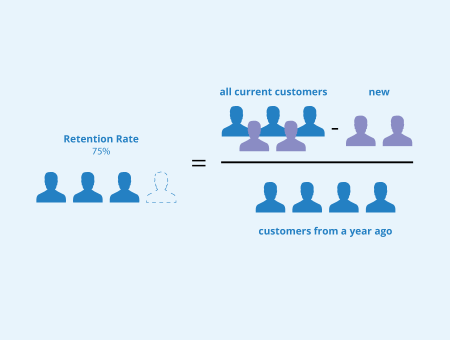Retention Rate
Contents
Definition
Retention rate is the percentage of customers who remain loyal to a company over a predefined period of time. The opposite would be the churn rate. For marketing, these two indicators are important to gain valuable insights as to where customer loyalty, customer journey, and similar areas can be improved.
Calculating the retention rate

The simplest retention rate formula divides the number of currently active customers by the number of customers from one year ago. For example, if a company has 1000 current clients and had 1500 twelve months before, the retention rate is 66.6 percent.
When calculating the retention rate, factors such as the observed time frame and the definition of active customers are important. The differentiation of time periods, for example, allows you to measure retention rates in connection with special marketing campaigns. It is not necessarily a purchase that determines what an active customer is, but criteria such as contact with customer service, reading the newsletter, or simply visiting a company's website.
The value gets a little more accurate with this formula:
Assuming that 200 out of 1000 currently active customers in the above example just joined last year, this results in a retention rate of (1000-200)/1500 = 53.5%.
Measuring and analyzing retention rate
Calculating your retention rate based on different criteria offers the advantage that you can divide your customer base into different segments. This makes it easier to improve retention rates through marketing campaigns. Examples of customer segments could be new customers or those that have purchased products requiring replenishment such as printer ink. Segments linked to the observation period provide information if measures to increase customer loyalty have been successful.
From a technical point of view, the most common approach to define segments for retention rates is tracking through cookies and other tools. In addition, you can use your conversion rates from retargeting and your own customer files to determine retention rates and optimize them through strategic marketing.
How to improve retention rates
There are various approaches that have proven to be successful in increasing retention rates The most common one is to start with the product or service itself. Is the price competitive? Does it have high quality? Is customer service rated positively? Can you keep promises such as uncomplicated online purchase and fast delivery?
Based on that, you should identify areas you can improve to achieve higher customer satisfaction and a better retention rate. For instance, many companies still ignore the fact that they need websites that are optimized for mobile devices because more and more users are shopping on their smartphones. Opening hours in customer service that are not oriented to customers' daily routine and work-life is another example of areas that need improvement.
Customer loyalty programs are a classic instrument in marketing that you can use to increase retention rates. Reward your customers’ loyalty with bonus vouchers, special discounts, and similar benefits. Invitations to special events, birthday cards, or raffles can also positively influence your retention rate. In online marketing, retention rates can be increased by personalized newsletters, high-value social media marketing, and related measures such as efficient customer relationship management.
Benefits of a high retention rate
Making sure that your current customers are satisfied is about seven times less expensive than acquiring new customers through advertising. This means in practice: While marketing expenses for winning new customers do not always pay off due to considerable scatter loss, investments in increasing your retention rate are much more targeted. Loyal customers are usually more willing to spend additional money and thus increase sales.
Studies show that customers act cautiously when making their first online purchase to test a shop or service. If you succeed with your customer journey to create a regular customer, the retention rate increases automatically. A positive side effect is that satisfied customers generate new customers through recommendations.
It is essential that you continuously monitor and optimize your retention rates. Market research shows the trend that even classical brand products such as detergents or coffee can no longer expect lifelong customer loyalty. Consumers are increasingly inclined towards trying out competing products and could, therefore, be lost forever. This makes it even more important to proactively understand the retention rate in marketing.
Related links
| About the author |
 |